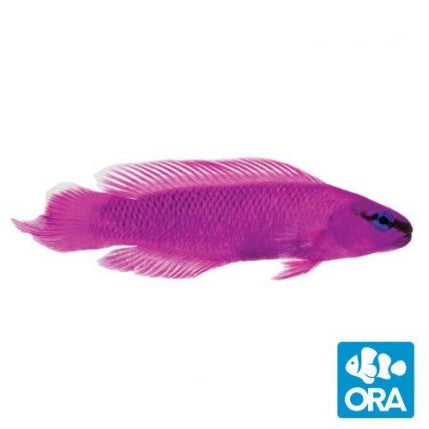Everyday low prices. Free Shipping Over $249. Or $29.99 Flat Rate Over $100
ORA Orchid Dottyback - Captive Bred
$ 44.99
Please select all options.
How to Care for Orchid Dottyback
Orchid Dottybacks are found only in the Red Sea. They’re observed in colonies near vertical walls or ledges, where they dart out to grab a meal from the passing zooplankton, then rush back. In the wild they are found at moderate to deep depths, and look blue rather than the magenta or violet color most aquarists are used to. This is due to the filtering of red light by seawater.
In aquariums, Orchid Dottybacks are quite easy to keep and feed. They are small plankton feeders so foods such as brine shrimp, krill and mysid shrimp are perfect. Orchid Dottybacks are moderately territorial and more than one can be kept per tank, as long as the tank has plenty of hiding spaces. Usually, adding multiple small individuals at once will likely result in a spawning harem.
The Orchid Dottyback, like other members of the family Pseudochromidae, lay eggs in a mass that are not adhered to a substrate but held together by filamentous threads. The egg mass is usually deposited in small nooks and caves and tended by the male. The eggs hatch in about 3-4 days and are larvae for 28-30 days.
Be sure to check out the two Orchid Dottyback hybrids produced at ORA, the Indigo and Electric Indigo.
Feeding: Offer the Orchid Pseudochromis a mixed diet of mysis shrimp and finely chopped meaty foods 4-6 times per week. Soaking all fish food with vitamins will help keep your fish healthier and make them less susceptible to disease. We recommend soaking food in garlic as well when adding new fish and whenever your notice ich or other disease in the aquarium. Garlic will help repel external parasites and will boost the fishes immunity.
Feeding Tips: Remember to feed slowly. Leftover food will cause nitrates and phosphates to rise. If you see food falling to the sand bed and into the rocks, you should feed slower and give the fish a chance to eat before adding a little more. Using a turkey baster allows you to target food to different fish. For example you can feed the aggressive fish on one side of the tank and then squirt a little bit on the other side for the less aggressive fish. This way all the fish get a chance to eat enough.
Maximum Length: 3"
Care Level: Easy
Family: Pseudochromidae
Reef Compatibility: Yes
Minimum Aquarium Size: 30 gal.
Range: Captive Bred ORA Farms
Diet: Carnivore
Water Conditions: 75-80° F; sg 1.024-1.026 (1.025 is ideal); pH 8.1-8.4 Ca 420-440 ppm, Alk 8-9.5 dKH, Mg 1260-1350, Nitrates <10ppm, Phosphates, < .10ppm
Water Chemistry: Maintaining Ammonia at 0 ppm, Nitrites at 0 ppm, and Nitrates below 10ppm will help to keep your Fridmani Pseudochromis happy and healthy. We recommend doing a water change soon after Nitrates rise above 10 ppm. Maintaining proper calcium (420-440 ppm), alkalinity (8-9.5 dkh - run it 7-8 if you are carbon dosing), and magnesium levels (1260-1350 ppm) will help to keep pH stable in the 8.1-8.4 range. We recommend a specific gravity of 1.024-1.026 with 1.025 being ideal for fish. Temperature should remain stable as well and should stay within a 2 degree range.
Category: 25-50, carnivore, easy, good, ORA Dottyback, ORA Farms, Pseudochromis, pseudochromis-fridmani
Type: Saltwater Fish


